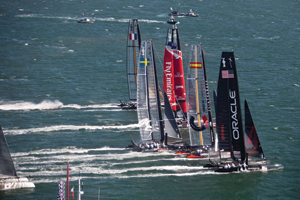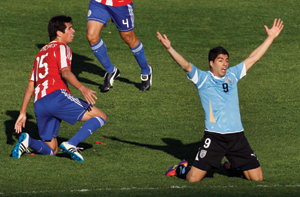Two and a half years ago, when International Olympic Committee member Richard Carrión was talking about potential bidders for Olympic rights, he listed the usual suspects: ESPN, Fox and NBC. But he also mentioned what many believed to be a far-fetched possibility: A company like Google could team with an over-the-air broadcaster on a competitive bid.
Two years later, it’s clear that Carrión’s comments, though premature, weren’t irrational.
YouTube, which is owned by Google, is building a sports operation, and though it’s unlikely the company will become a sixth player in the bidding wars for sports rights any time soon, it is intent on dabbling with online rights.
The company announced two weeks ago that it will launch seven sports channels: a soccer channel programmed in part by Major League Soccer, two sports channels programmed by Bleacher Report and SB Nation, an athlete channel called NOC (Network of Champions), and three action sports channels programmed by Wasserman Media Group, NBC’s Alliance of Action Sports (Alli) and Red Bull Media House.
Claude Ruibal, who founded World Championship Sports Network and was hired earlier this year as YouTube’s head of sports content, described the effort as an experiment. He said that after years of relying on user-generated content to attract viewers, the company has decided to pay for higher quality content in hopes that people will come to view the programming and stick around to watch user-created videos, or vice versa.
 |
| Photo by: NEWSCOM |
“We’re sort of just feeling our way,” Ruibal said. “We’re hoping it will generate a lot of user interest and advertiser interest.”
Ruibal said sports and entertainment were the two categories that YouTube focused on when it decided to launch the channels. The company selected soccer and action sports as founding channels because both already attracted a significant number of viewers for user-generated content and original content such as Ken Block’s Gymkhana video series
 |
Photo by: AP IMAGES
|
and press briefing clips on FC Barcelona’s official page.
“We thought [the channels] would be additive,” Ruibal said.
The presence of YouTube in the sports rights marketplace — even if it’s only bidding on niche sports right now — is being closely monitored by everyone from rights holders to TV networks to video distributors. Because of the deep pockets of its parent company,
 |
YouTube streamed America’s Cup (top) and Copa America (center), and MLS is helping program a new channel.
Photo by: GETTY IMAGES
|
Google, and its international platform, sports media executives see YouTube as a potential threat.
“The economic model is not such that I think they would go out and write a check for $4.5 billion for the Olympics to put on Google,” Chris Brearton, managing partner, O’Melveny & Myers, said at SportsBusiness Journal and SportsBusiness Daily’s Sports Media and Technology conference in New York last week. “I see them more now as somebody who is involved in archival programming, interstitial programming, maybe being a partner with [an existing broadcast or cable channel] in a bid for something to help monetize it.”
That’s a structure that some media executives find attractive. Turner has been working with YouTube on its NBA channel since 2007 and believes the company could be a viable partner to bid on future rights.
“We [worked with Google] to understand how it works and to be able to figure out how we work together, so as the rights fees keep going up, we find different ways to monetize them,” said Lenny Daniels, Turner Sports chief operating officer and executive vice president. “We learned it’s not a big business right now. It’s a great place to play. It’s a great place to learn who’s going where and when they are going to play. I don’t think they’re ever going to take the place of what we’re talking about here overall.”
When it comes to live rights going forward, Ruibal said Google will be opportunistic. He said it will show mostly underserved sports that have a disjointed, international audience with pockets of fans spread across a number of countries. He pointed to fencing as an example.
Last month, the International Fencing Federation streamed its world championships from Italy live on its YouTube channel.
YouTube already has begun experimenting with live sports. It partnered with the Indian Premier League, a Twenty20 cricket league, to stream games worldwide earlier this year, and it also streamed Copa America soccer games this summer and offered multiple video streams from the America’s Cup sailing competition.
Terms of each of those agreements differed, and it’s unclear if YouTube paid any production costs or rights fees. None were exclusive broadcasts but the total viewership was encouraging.
“We had really strong viewership and that said to us, ‘We think there’s an audience here for us,’” Ruibal said.
At least initially, Google’s cost structure is low enough that any bid on media rights for a major sports property appears to be a long shot.
Each participant in its YouTube channel plan was paid a production fee, reportedly worth $5 million, to deliver original content for its respective channel. YouTube will sell advertising against the channel, and after recouping its production investment, it will split advertising revenue with the content provider. They also jointly own the channel.
“It seems that YouTube made a decision that it will program largely non-premium channels,” said David Bank, managing director of global media and Internet research for RBC Capital Markets. “It doesn’t sound like they will be aggressive about getting into the rights business any time soon.”
The most immediate upside in launching a YouTube channel under those terms for Wasserman Media Group, Alli and others is the free marketing a channel offers. Each was handed what amounts to a $5 million marketing budget by YouTube to fund the creation of content that they believe can raise recognition of their athletes or brands.
“The visibility of YouTube is unparalleled,” said Circe Wallace, Wasserman’s senior vice president, action sports. “We couldn’t put something [on a website] with the same profile as YouTube. The talent we work with understand this is a great marketing opportunity for themselves, their sponsors and their own brands.”
Possibly the biggest winner under those terms is MLS. With little or no cost up front, the league will be able to mix its highlights and original programming around its teams and players with highlights and footage of other leagues, teams and players worldwide. The channel can put the league’s teams before a global audience alongside soccer powerhouses like FC Barcelona.
In short, the league gets a channel — underwritten in part by YouTube — that has international reach without having to haggle with cable operators over carriage.
In fact, international is the biggest upside for everyone participating, and the biggest focus for YouTube.
“I look at this globally, not domestically,” Ruibal said. “The U.S. is a key and important market, but for sports it’s just a piece and not even our biggest piece.”
Derek Chang, DirecTV executive vice president of content strategy and development, said YouTube’s strategy made sense, especially if it’s able to keep its costs low. That view suggests YouTube, and its parent company, Google, will not be bidding on premium sports rights any time soon.
“The hurdles aren’t high to make money on it,” Chang said. “If they can drive more eyeballs to the platform through that and monetize it enough, it’s just a different business model that may be a good enough business model for what they’re trying to do with it.”
For Brian Bedol, a cable industry veteran who founded Classic Sports Television in 1995, the YouTube channels feel a lot like the early days of cable. Bedol, who now runs Bedrocket, a new company that programs the Wasserman and soccer sports channels on YouTube, compared the new channels to CNN and MTV 25 years ago.
“What you’re seeing is a bit of a tip of the iceberg,” he said. “This is where the young male demographic gets more and more of its entertainment. If you’re in sports, you need to be looking at how you’re delivering sports over the Internet.”






